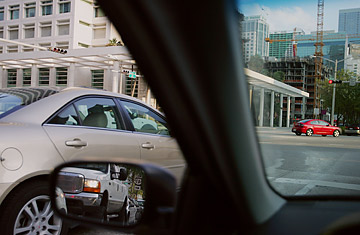
Vehicles drive through the streets of Miami, Fla.
(2 of 2)
Nowhere does that culture look more extreme than in Florida, which has one of the most inadequate public transit systems in the U.S., as well as a dearth of sidewalks and bike paths. "As Florida's growth burst at the seams, there just wasn't planning for sidewalks or anything else pedestrian-friendly," says Glenn Victor, spokesman for the nonprofit Florida Safety Council in Orlando. "This study should be considered very closely as part of the argument for endorsing projects like light rail. It's an impetus for Florida to catch up."
And it's not too late for that to happen. One of the study's more interesting finds is that car-crazy regions that have begun to play catch-up, like Southern California, are also seeing fewer pedestrian deaths. Unreformed Sunbelt-sprawl centers like Atlanta and Houston round out the top 10 most dangerous cities; but Los Angeles ranks only 27th. "In L.A.," says Goldberg, "they've started to recognize that biking, walking and public transit are a big part of their future. It's a good sign that the pendulum is swinging back." One way states and local governments can bring that about, he adds, is by adopting so-called complete-streets policies that build new thoroughfares or revamp existing ones with more than just car usage in mind.
Even some parts of Florida are now embracing that approach. Lee County, which includes Fort Myers, passed its own complete-streets resolution this month after the TFA study was released. And to its credit, Florida's Department of Transportation has ramped up sidewalk-construction campaigns, which Victor says have been most impressive in school zones. Florida's cash-strapped school districts have had to cut back on bus service for students in recent years, forcing more children to walk to school — and prodding state officials to discover how little access those kids have to safe crosswalks and sidewalks in many Florida cities. (Miami drivers are also notorious for carelessly parking their cars on sidewalks near schools, forcing children into the streets.) The state's Safe Routes to School program has been a particular success in that regard.
What's still alarming in states like Florida is the frequency of hit-and-run deaths. Most U.S. counties see only a handful of them each year; but Miami-Dade County in the past decade has seen as many as 46, a good number of them taking the lives of children like Ashley. It's partly due to a mind-set that views pedestrians as nuisances. To crack down on that way of thinking, Risete, Ashley's mother, has pushed for a number of measures in Florida — including the Ashley Nicole Valdes Alert System in Miami-Dade, which notifies the public (by cell phone for those who sign up for it) of the description of an alleged hit-and-run driver's car. (The driver arrested in Ashley's death is now awaiting trial.) Risete, 34, now a paramedic, has also got the county to install stoplights at the dangerous intersection where Ashley was hit.
As for Orlando, it's ironic that the site of Disney World — where inside the theme parks, at least, walking is king and monorail systems move visitors around so smartly — is America's most dangerous place for pedestrians. But that decidedly unsunny reality was driven home this month when a Massachusetts cardiologist in town for a medical conference died after being hit by a car while jogging.
